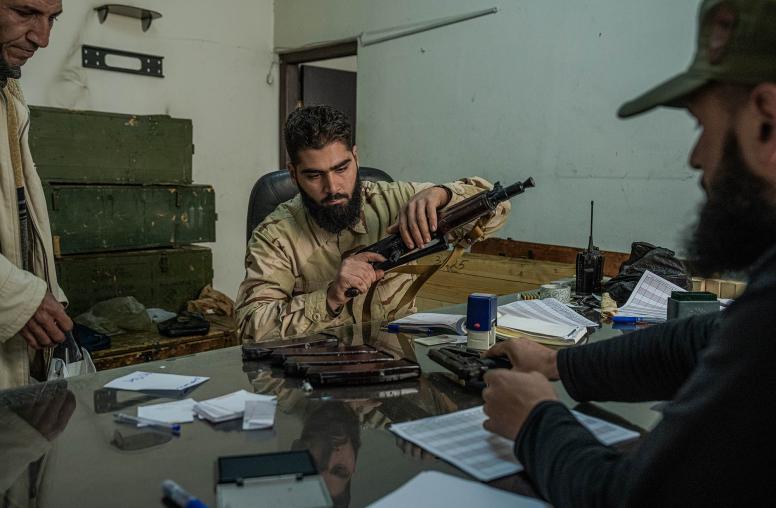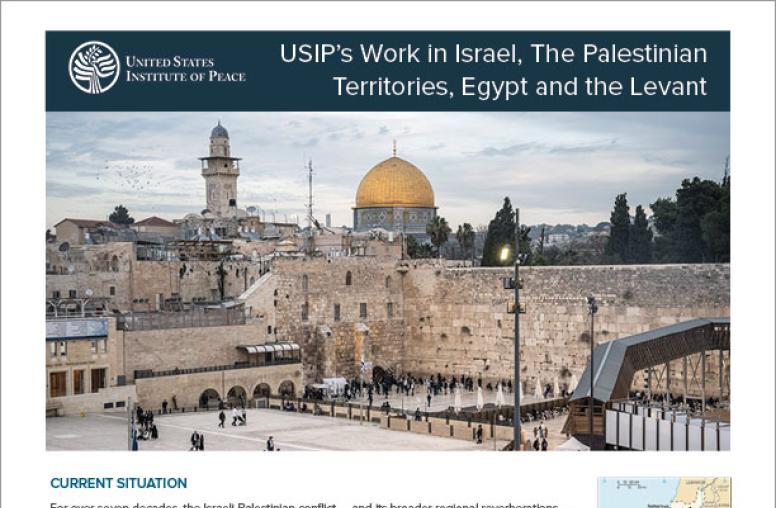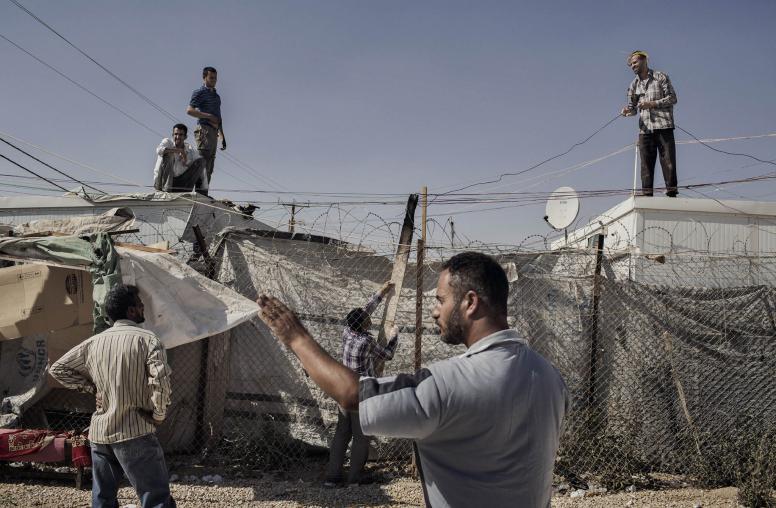Syrian Expatriates Examine the Roles of Women and Minorities in Uprising
Syrian expatriates appearing at the U.S. Institute of Peace (USIP) on March 9 assessed the challenges facing women and ethnic or religious minorities in the country’s increasingly deadly revolution, asserting that opposition sentiment broadly envisions a post-Assad Syria that will be inclusive and respect their rights in a diverse country.
March 15, 2012
Syrian expatriates appearing at the U.S. Institute of Peace (USIP) on March 9 assessed the challenges facing women and ethnic or religious minorities in the country’s increasingly deadly revolution, asserting that opposition sentiment broadly envisions a post-Assad Syria that will be inclusive and respect their rights in a diverse country.
The event, Who Owns the Syrian Revolution?, was co-sponsored with United for Free Syria and the Syrian Emergency Task Force. It came as the security forces of Syrian leader Bashar al-Assad press their attacks on oppositionists and civilians caught in the fighting in such cities as Homs and Idlib and as the Syrian National Council (SNC) struggles to regain the initiative against the Syrian regime. At the same time, former United Nations Secretary-General Kofi Annan, functioning as a U.N.-Arab League envoy, has launched a new diplomatic initiative aimed at achieving a cessation of hostilities, humanitarian access and eventual political dialogue.
The U.N. has estimated that more than 7,500 Syrians have died in the uprising, which began in the winter of 2011, though some of the activists appearing at USIP put the number of dead at greater than 9,200.
Opposition leaders have expressed support for principles of inclusion, equality and tolerance, said Steven Heydemann, USIP’s senior adviser for Middle East initiatives, but women and minorities “have experienced some regression” as the uprising continues. “The stakes for the Syrian revolution are very high,” he said.
Heydemann noted that “the Syrian regime has done a great deal to reinforce the fears of minorities,” portraying itself as the best defense against recriminations or other risks of change. At the same time, he said, “the opposition itself has struggled to make a compelling case to quiet those fears and explain how they stand to gain in a new Syria.”
Women and the Future of the Syrian Revolution
Women active in the Syrian opposition are providing humanitarian aid, collecting medical and technical supplies, providing care to the wounded, building support for the cause and handling media and information needs, said Rajaa Altalli, who is director of international relations for Syrian Christians for Democracy, as well as co-founder of the Support Center for Syrian Minorities, based in Washington. She predicted that “in our new, free and democratic Syria” discrimination against women would not be a problem.
Farah Al Attasi, a Washington-based author and commentator and executive director of the American Arab Communication & Translation Center, said that women are “at the forefront of the Syrian revolution,” adding “she [women generally] is paying the highest price in this revolution.” Attasi said that more than 120 anti-government demonstrations in Syria have been led by women. “This revolution is not about man and woman, not about Christian and Muslim. It’s about regaining our citizenship,” she said. She said it would be useful to create “a roadmap” for women’s issues in a future Syrian constitution.
“We are mothers at home and activists on the street,” added Rasha Alahdab, a founding partner of Syrian Women for Syria and a founding board member of Syrian Expatriates for Democracy. An attorney and member of the law office of the SNC, Alahdab called herself a devout Muslim but one with “no hijab in my brain.” She said, “Today, Syrian women are equal to their male counterparts in the Syrian revolution in every way.” However, she also expressed concern about a post-Assad future. “I have fear also that after Assad I will lose my rights,” she said, but remarked that under Assad there are “not that many rights to lose.”
Rafif Jouejati, the CEO of a Virginia-based management consulting firm, is serving as the English-language spokesperson for the Local Coordination Committees in Syria, the National Consensus Movement and Activists for a Free Syria. Jouejati said Syrian women are active in running revolutionary coordinating committees and disseminating information. Some have been delivering gift-wrapped revolutionary slogans placed on doorsteps overnight, she said. Women—and men—have also suffered grievously, she said. “Rape has been used as a tool against our people,” she said. Jouejati urged that more training and women’s empowerment programs be made available. “We are united behind a common goal and that is to overthrow the regime,” she said.
The Roles and Challenges of Minorities in Syria’s Revolution
Dima Moussa, a Syrian born attorney and member of the SNC, said that her Christianity—a religious minority in majority Sunni Syria—“had never been an issue” in the past. But she said the regime has “planted seeds of division” with warnings that Christians would be repressed by “an Islamist uprising.” Moussa nonetheless expressed optimism about ethnic and religious tolerance in a future Syria.
Abed Alo, a physician and ethnic Kurd born in a village north of Aleppo, is a pro-democracy suporter who is also involved in the Syrian Kurdish Diaspora in the United States. Alo said that the Syrian regime in the 1960s had deprived some 150,000 Kurds of citizenship and moved Arab villagers into traditionally Kurdish areas along Syria’s border with Turkey. Repression had affected “all the Syrians in the last 50 years,” he said, “but the Kurds are repressed twice.”
Oudei Abouassaf, a member of the board of Syrian Expatriates in Support of the Syrian Revolution, was born in Damascus to a family originally from the Druze-majority city of Sweida, in southern Syria. “The Druze’s participation will give more credibility to the uprising,” he said. He said that some older Druze are concerned that a future, theocratic government would suppress minority religious rights but that younger, more educated Druze reject that fear. “I don’t fear a theocracy,” he said. “The younger generation really has a different thought process.” He urged that Sunnis in the opposition do more to “speak over those extremist voices” being heard at times.
Oubab Khalil, an Alawite raised in Lattakia province, is a lawyer who emigrated to the United States in 2006 and is on the board of the Syrian Expatriates Organization. Khalil said “we all fear the chaos.” But he hastened to add: “I have no fear of anything called Islamists, no fear of the majority ruling.” With the Assad family part of Syria’s Alawite minority and some Alawites fearing their prospects in a post-revolution Syria, Khalil urged that the anti-Assad opposition send a stronger message: “They [Alawites] are full partners in the future of Syria….There’s a place for them.” He said that Alawites should be reassured that a revolution overturning the Assad regime will not result in retributions against them as an ethnic community.
Najib Ghadbian, an associate professor of political science at the University of Arkansas and SNC member, noted that Syria is a society whose diversity can be transformed into a positive force and celebrated—or can become a destructive force. Ghadbian, a Sunni, called fears among some Kurds, Christians and Alawites “serious and genuine.” The opposition should do more to sketch out a vision of a civil, modern Syrian democracy to replace Assad. He cited Kurds being deprived of citizenship, Christians’ fears of being targeted by a more Islamic-oriented government and Alawites fearing retribution. He acknowledged “extremist voices” within the Sunni community that may grow louder with the intensifying violence, but he argued that the majority favors a peaceful transition. He urged members of minority communities to stop their silence about the revolution and “get involved in changing the future of Syria.”
Explore Further
- Turmoil in Syria: Reshaping the Middle East?
Peace Brief Series
The Institute invited leading experts from the U.S. and across the Middle East to identify key vectors of influence Syria’s neighbors are bringing to bear on the conflict; to forecast how the on-going conflict in Syria will affect the delicate and volatile regional balance of power; and to examine how the Syrian opposition and the Syria regime are factoring in regional and cross-border dynamics. - Global Change, Peacebuilding and USIP
USIP leaders explain the effect that events around the world and here at home will have on the U.S., and the contributions the Institute can and does make during a time of tremendous challenge – and opportunity.


